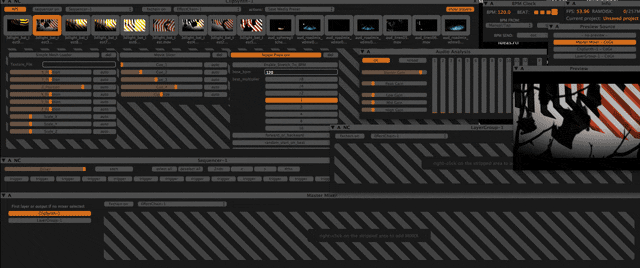"Given there’s quite a range of existing VJ software – what inspired you to build CoGe?
It’s a kind of funny story  I saw a first vj gig in 2001 in a music festival, and I fell in love with that thing. Never thought about being a vj, I made music before, so I’m from audio land. Then, when I got my first Mac in 2006, and saw Quartz Composer and saw how Quartonian works, I just think I can do something funny_ – never thought about to make a commercial application, haha
I saw a first vj gig in 2001 in a music festival, and I fell in love with that thing. Never thought about being a vj, I made music before, so I’m from audio land. Then, when I got my first Mac in 2006, and saw Quartz Composer and saw how Quartonian works, I just think I can do something funny_ – never thought about to make a commercial application, haha  – with a kind of sync with the music, so just tried it. It was the early version of CoGe, called LovQC, haha
– with a kind of sync with the music, so just tried it. It was the early version of CoGe, called LovQC, haha  You can find some test videos made with it on Youtube.
You can find some test videos made with it on Youtube.
Then I spent more time on the software, added lots of new features, and with 2 friends we just created a VJ team Luma Beamerz and CoGe was born. Anyway, the first version of the app was a 50mb QC composition with just an interface, then I started to learn Cocoa, Obj-C, OpenGL and other stuffs - Vade helped me a lot with the GL stuff, so CoGe now is a “real” application.
Anyway, I never used any other VJ softwares, I just created my own for my own wishes: triggering different points of movie on beat, sequencing still images, etc.
So, I think the big difference between applications is the workflow, so it depends on how you, the user think about creating things. All VJ software has a bunch of same features, triggering files, change speed, colors, etc., the big difference is the workflow, so I think an artist will choose software which works like his/her workflow. For an other example, modularity is a great thing, but a lots of users happy with built-in features in apps and never thought about it can be different.
It’s integrated into your app quite a lot – but what attracts you to Quartz Composer?
The great thing with QC is very easy to learn the basics and use for non-programers too, you shouldn’t be a coder to do a simple image rotation for example. On a developer side, the system integration – using QC stuff inside an application is easy – is a very important thing in my opinion.
The great thing with QC is very easy to learn the basics and use for non-programers too, you shouldn’t be a coder to do a simple image rotation for example. On a developer side, the system integration – using QC stuff inside an application is easy – is a very important thing in my opinion.
It also have a lots plugins, and great media handlers, so a lots of things is possible with QC – basically, CoGe just connects QC stuffs under the hood, nothing magic.
What impact does Syphon have on how developers might approach VJ software today?
I think Syphon has a lots of potencial and its a very great stuff – connecting different sources into other applications is really opens some doors, just think about “sending” images from Max and Processing, and you can mix them in CoGe in a very simple way. That couldn’t be possible before Syphon.
I think Syphon has a lots of potencial and its a very great stuff – connecting different sources into other applications is really opens some doors, just think about “sending” images from Max and Processing, and you can mix them in CoGe in a very simple way. That couldn’t be possible before Syphon.
Do you have opinions about whether VJ software should provide more advanced audio controls? And sequencing controls? Or is it better to sync VJ software to something like ableton?
I really like sequencing, using clips and stills in sequencing can provide really good things. With audio controls you can have some fun, but the really good choice is syncing with an audio host if you would like to make real AV things.
What are the challenges of making a good performance interface?
It depends on your workflow and what you wanna do in the performance. I recently just using 3 layers with a lots of media presets and some simple effects. If you using a lots of things the new Aligner stuff helps you to make smaller groups on the screen, I think its a very important feature.
It depends on your workflow and what you wanna do in the performance. I recently just using 3 layers with a lots of media presets and some simple effects. If you using a lots of things the new Aligner stuff helps you to make smaller groups on the screen, I think its a very important feature.
What are you happy about in CoGe today?
CoGe 1.1 release makes me happy, i got a lots of positive feedback on it, and saw some really nice things created with CoGe. Also happy because i have a lots of ideas for the future
CoGe 1.1 release makes me happy, i got a lots of positive feedback on it, and saw some really nice things created with CoGe. Also happy because i have a lots of ideas for the future
Thanks Tamas!"

Nincsenek megjegyzések:
Megjegyzés küldése